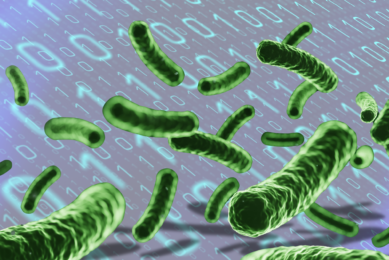Probiotics in sow and suckling piglet feed – 1 extra live pig per sow
It all starts with the sow. Her genetics, traits and health lay the foundation for the coming pigs. Over the years, the sow was bred to deliver more pigs per litter, and the focus has shifted from the number of piglets born per litter to also weaned pigs per litter. Probiotics can help pig producers achieve this goal.
In order for the sow to be able to yield the most, there are many parameters that need to go up to a higher level. The composition of the feed, including adding feed additives is one of these. Common for all feed additives is that the price of the product must at least be covered in the pig production profit.
Probiotics in pig feed aids in maintaining a high health status
The main idea of adding probiotics to the feed is to improve the intestinal flora, as it reduces the number of harmful, pathogenic bacteria in the intestines, such as E. coli, salmonella and clostridia. A healthy intestinal flora not only helps to maintain a high health status, but also contributes to an increased nutrient absorption and feed conversion. Probiotics with enzyme-producing bacillus can help to optimise feed conversion further as they contribute to the breakdown of the feed.
Probiotics added to pig feed must meet some criteria
However, before the pig can take full advantage of the added probiotics, there are some criteria that must be met. Among other things, the product must be capable of withstanding the stomach’s pH barrier. The three aforementioned types of probiotics can be added to meal feed, but if the product is to have a pellet mixture added, it is important that it is heat stable (> 85ºC). Otherwise, it cannot survive the pelleting process. A product consisting of lactic acid bacteria or yeast cannot withstand the high temperatures, while a probiotic consisting of bacillus can. Bacillus is added to the feed in an inactive form and will be activated in the intestine where it will proliferate.
Feed absorption for nursing sows is essential
Feed absorption during the nursing period is essential in relation to milk yield, as well as to the maintenance of the sow’s condition. If the sow loses too much weight during nursing, it can have a negative impact on her subsequent reproductive performance. In addition, a high weight loss can have a negative influence on feed consumption, as it will be necessary to supplement with extra feed to get the sow back into in good condition. According to the Danish Pig Research Centre’s (VSP) Report No. 618, 1 kg of gain costs 3.2 FEsow in the early gestation period.
Feeding trial: sows fed probiotics had lower weight loss
Results from a German feeding trial showed that sows given probiotics had a lower weight loss compared with sows that had no probiotics. This trial included 209 data sets, and the sows’ condition was evaluated using a scale from 1 to 5, where 1 was a very thin sow and 5 was a very fat sow. A condition score of 3 was found to be optimal (Table 1). Before farrowing, the sows had an average condition score of 3.5. After nursing, the sows in the trial group had a condition score of almost 3, while the sows in the control group had a condition score of just over 2. There were 65 sows in the control group and 144 in the trial group. The probiotics used, PorcBoostTM probiotics, was mixed in with the gestation feed two weeks before the expected farrowing, as well as in the nursing feed.
Scoring scale for condition evaluation – table 1

Feeding trial: nursing sows fed probiotics had lower weight loss
Another European feeding trial also found a lower weight loss during the nursing period in sows given PorcBoostTM probiotics, as well as a lower return rate. Weaned pigs from sows that have had PorcBoostTM probiotics also had significantly higher weaning weights. This trial included 126 sows and 63 sows, respectively, in the trial group and control group.
A healthy sow gives healthy pigs Bacillus ingested with the feed colonises in the intestine and thus reduces the presence of coliform bacteria and the prevalence of lactic acid bacteria increases. An increased proportion of lactic acid bacteria and bacillus can be found in the sow manure, and through the piglets’ natural curiosity and rooting behaviour, bacillus will be ingested and colonise the piglets’ intestine. Just as in the sow, it will create a good environment for the good bacteria and the intestinal flora of the piglet will be optimised (Figure 1). One weaner more per year sow As mentioned earlier in this article, the number of weaned pigs per litter is an area of focus in pig production.
PorcBoostTM probiotics route through the sow and to the piglet – figure 1
Feeding trial: lower mortality in piglets from sows fed probiotics
Results from feeding trials conducted in Danish sow units (13,000 sows in total) have shown a reduction in mortality among piglets from sows that have had bacillus based probiotics added to the feed. This trial also showed that there was 0.9 more weaned pigs per sow from sows fed with bacillus based probiotics (Table 2). The number of weaned pigs per year sow is also a focus in other European countries, where the same product has been tested through feeding trials in Europe. The result is further confirmation of the excellent results that were found in Denmark.












